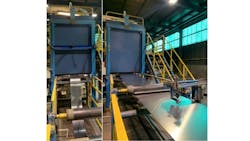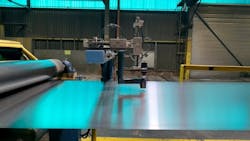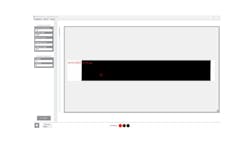How TI Fluid Systems Improved its Steel Strip Inspections
TI Fluid Systems had a problem. The company produces automotive fluid storage, carrying and delivery systems. That includes steel coils to fabricate pipes for brake and fuel supply circuits. Any perforations in the steel, no matter how tiny, can cause safety issues. TI Fluid (Liège, Belgium) had a camera-based inspection system in place, 3 meters above the steel strips on a production line. However, this system required complex calibration and had frequent operational failures and false hole detections. The company needed a dependable and highly precise inspection and detection system to conform to the automotive industry’s stringent safety standards.
The steel coil producer sought help in developing and implementing an inspection system to detect every potential hole at least 1 mm in size. It needed to do so on steel strips moving at 95 meters per minute, or 1,580 mm per second.
The inspection follows a copper or nickel electrodepositing coating process on the original steel strip. “After inspection, the coil is rewound before being sent to the pipe production line. If a defect is detected, the steel strip is automatically marked at the right position,” says Arnaud Philippart, CEO of InDeep-solutions (Ferrières, Région Wallonne, Belgium), the company that spearheaded the development of the new inspection process.
The holes might have different origins, says Philippart. The defects could be present on the coil when delivered to TI Fluid Systems. Or they could be generated during the trimming process. It’s also possible a metallic foreign body, such as screws or iron shavings, could impact the production line and cause the holes.
Developing a New Inspection Process
InDeep-solutions specializes in industrial process monitoring and production quality inspection. The company initially tested a laser profiler for the role, but there was not sufficient frequency and resolution to identify the holes. InDeep brought phil-vision GmbH (Puccheim, Germany) in as a partner to select the optimal camera technology to use. phil-vision specializes in machine and computer vision, distributing image processing components and integrating them. The phil-vision experts recommended Teledyne DALSA’s mono compact image sensor AxCIS (AX-FM-08B12H-00). This technology was originally developed to inspect printed materials and batteries. The small, quasi-telecentric line scan cameras are often used for highly precise measurements.
Related: Next-Gen Conact Image Sensors Enhance Inspection of Batteries and Printed Material
In addition to recommending components, the phil-vision team provided feasibility testing and software integration.
The team integrated the AxCIS sensor into compact housing, minimizing alignment complexities. They paired it with an Xtium2 CameraLink HS frame grabber, also from Teledyne DALSA (Waterloo, ON, Canada), for a short working distance, which also simplified installation. The setup did not require complicated cabling, complex alignment or calibration.
Developers fixed the sensor at a minimum acquisition frequency of 10kHz for a 0.15 mm resolution in the direction of travel, though they received a higher 0.022 mm resolution along the steel strip’s width. These resolutions were effective for detecting defects.
The settings allowed the sensor to gather and measure in 4,000 line batches, using a reduced CPU load during continuous monitoring. The system maintained a 0.4 second response time. The software analyzed each image immediately upon release, building the next image in parallel during processing.
Related: Titan Cement Adds Inspection System to Production Facility
“Although the AxCIS contact image sensor is primarily designed to capture clean images in printing production lines, it possesses many characteristics that extend its functionality to include small hole detection,” says Philippart. That includes a “very high resolution and very high acquisition frequency,” he adds.
“Thanks to the back light, the edges and holes are clearly visible,” Philippart says. Contact image sensors already have lighting built in, though it isn’t always useful for each application. For the TI Fluid Systems project, the developers used a simple LED ribbon for lighting, says Philippart. “The light source must be positioned at the bottom of the steel strip with the sensor situated above it. This configuration enables a substantial contrast. Consequently, the built-in light is not interesting for this particular application.”
Customized Software Designed to Minimize Human Intervention
As part of the process, InDeep created customized software, which runs on a rugged PC, to provide high-resolution images and highlight the defects with a red square. It can display the last 10 detected holes while archiving the data for six months. This assists with traceability and quality audits. The testing found that the new system identifies fewer false positives, while not missing any holes.
Another benefit is that the system is already calibrated. “The software only needs to be configured during the commissioning,” Philippart says, and it is designed to be easy to use. Developers set sensor properties, such as exposure time and frequency, along with the communications and processing parameters, such as threshold and buffer size. Then the software is fully autonomous. “It starts automatically on boot, loads the configuration and starts doing its job. There is also a windows service checking that the inspection software is running,” he adds.
Related: Robotic System Loads Bobbins in Textile Manufacturing Process
After the solution powers on, it auto-launches the software. It then detects the hardware and begins acquiring data. The system begins image buffering, temporarily storing image data before processing it. The image analysis occurs next, including edge detection, width measurements and hole detection. These results are communicated to the programmable logic controller, and the image is recorded in case of a detected defect.
While InDeep created the software, phil-vision supported driver development, sensor timing, programming and software integration, “thus contributing to the successful implementation of the inspection system,” Philippart says.
The End Results and Next Steps
TI Fluid’s inspection system has been running online for months now, says Philippart. In-Deep solutions says it is reliable, accurate and user-friendly, meeting the highest industry standards. TI Fluid ordered a second sensor as a spare part, “proving the importance of the system for their production,” he says. The repurposing of the AxCIS sensor and this setup could be interesting for other companies, he adds, and he’d like to duplicate this system elsewhere, in the future.
About the Author

Deborah Abrams Kaplan
Freelance Journalist and Author Deborah Abrams Kaplan covers tech topics and manufacturing/supply chain for clients including Manufacturing Dive, Supply Chain Dive, Forbes, Fast Company, Kyndryl, GE Healthcare, Johnson Controls, ServiceNow, P&G Signal360 and DHL. You can see her work at www.kaplanink.com.




